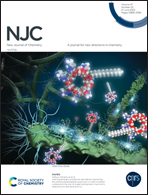Binding symmetric porphyrins to the c-MYC promoter Pu24I G-quadruplex: toward more specific ligand recognition by flanking bases†
Abstract
Stabilization of G-quadruplexes formed in the promoter regions of oncogenes with small molecules is recognized as a convenient method to control oncogenes’ overexpression in cancer cells. Due to a huge number of potential G-quadruplex structures in DNA, the success of this method is critically dependent on ligand–quadruplex selectivity. Although external π–π stacking of the ligand to the top G-quartet was extensively exploited in the design of new ligands with aromatic cores, it is believed that symmetric porphyrin derivatives are not capable of specifically interacting with flanking nucleotides. Here, we show that TPyP4, an analogue of TMPyP4, exhibits more pronounced selectivity toward the overhang. To this end, we examined the binding of TMPyP4, TPyP4, TPyAP4, TBP, and TMABP4 to the c-MYC promoter Pu24I G-quadruplex via density functional theory calculations and molecular dynamics based on the classical force field. The ranking of ligand binding energies in the end-stacking binding mode, TMABP4 > TMPyP4 ≈ TPyAP4 > TPyP4≈ TBP, was mainly governed by van der Waals interactions in the binding pocket. TPyP4 was also found to intercalate between the A3 and G2 bases of the overhang and simultaneously stack on two guanine bases of the top G-quartet. The binding affinity for intercalation was stronger than for end-stacking. We propose that the metalation of TPyP4 with a cation whose favored coordination geometry is octahedral might stabilize intercalation over an end-stacking binding mode to a greater extent.



 Please wait while we load your content...
Please wait while we load your content...